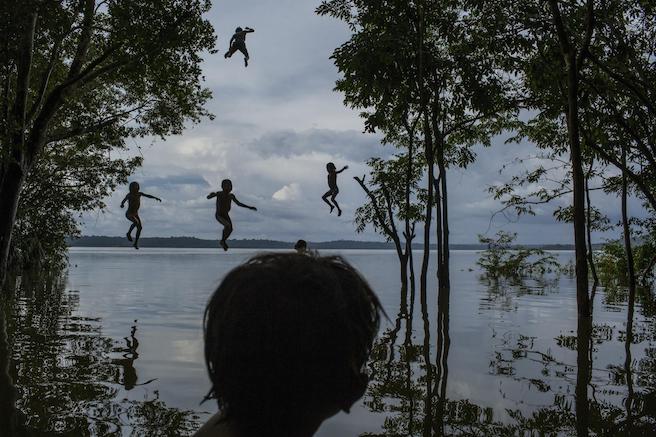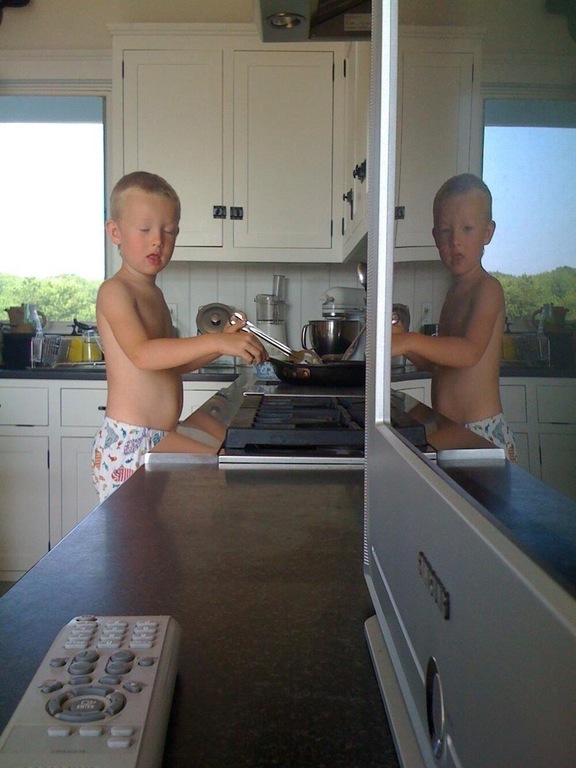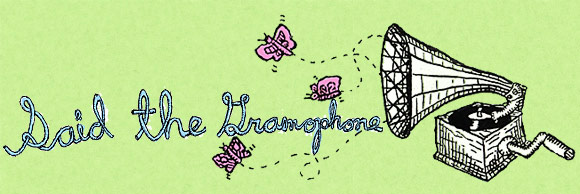Goldfish - "Charm". In 1996, a band called Goldfish started recording an album. 21 years later, they finished it. Predictions of the Future is a time-capsule from a departed Montreal - tough, luscious, part-tarnished. Punk-rock from an era when punk was more glinting, when harshness and softness went together like scissors through silk. Like Lush or the Breeders, Goldfish were a four-piece. They were a band with two singer/guitarists, Carrie Haber and Vicky Klingenstierna. They tangled round the city; some nights it seemed like they owned the place. (They are probably the only act to have ever opened both for Natalie Merchant and for Fugazi.) Predictions was among the first material ever produced by my friend Howard Bilerman (who has since recorded classics like You Want It Darker, Funeral, Lhasa and 'Allelujah! Don't Bend Ascend). They laid it down at his parents' house. All this feels like folk-tale, fake history, but it's true. A band I'd never heard of that rocked and toiled, then went away. I moved to Montreal in 2000. By then Golfdish had disappeared. But the marvel of the thing is that they somehow clawed back. Two decades later, Haber decided that her band had unfinished business. "I realized that we're going to die," she told the Gazette's Jordan Zivitz. "I have a lot of unfinished projects, and this is not one I wanted hanging over me on my deathbed." This wasn't so easy: Predictions was recorded to tape; tapes don't last forever; but they retrieved 'em, baked 'em, set about completing that which wasn't quite completed. And now: here. "Charm" and all the rest of this artifact, like noticing a footprint in the sidewalk you've tramped over ten thousand times.
[buy Predictions of the Future from the Dears' label, Ting Dun]
11:11 AM on Jul 24, 2017.

Daniel Romano - "Ugly Human Heart Pt. 2". A silver-screen sheen on you, the streets, your ugly human heart. A whole sky gone backdrop, a whole city gone set. Dashing like a dancer, feeling beer-bittersweet; or if not beery then at least the taste of black liquorice on your tongue. Oh, those silver pinprick stars. Oh, those rainbow oilspots and ruby flashing lights. What a night, what a day, what a loop-the-loop of sorry. Running under lampposts as there's Bowie beside you, or Lennon, and Kate McGarrigle. Running under lampposts like you can outrun your scampering shadow; dart this way, that, and maybe you'll finally lose that midnight thing, be rid of it and loose.
[buy Daniel Romano's wondrous glam-country masterpiece, Modern Pressure]
(photo source)

Harmony Trowbridge - "It's Your Funeral".
Sinjin Hawke - "Don't Lose Yourself To This".
The earth is filled with species to which, or to whom, these pieces of music are identical. To a silverfish, a coral polyp, a tulip, these tracks are mostly indistinguishable, interchangeable, the noise of homo sapiens. Don't ask a fern to tell you the differences between Trowbridge's melancholy, with its glinting naked edge, or Hawke's electronica, all jackknifing cascades. Perhaps a whale could tell you something, or a blue jay; perhaps, perhaps not. I could tell you something, I can tell them apart. But there's a strange power in doing the opposite - in telling them the same. Fission is division, fusion is conjoining. "It's Your Funeral" and "Don't Lose Yourself To This" are so unalike - yet go ahead, listen for your minutes, and wherever you find commonality you are also finding might.
Is there a greater power than connecting unconnected things? Turn today into yesterday, lead into gold. The feelings and frameworks linking two sets of sounds: one murmured and acoustic, the other jabbering and artificial. Each of these songs conceals itself from sunlight. Each feels a shiver. Each is a processing, uncovering, not the settling of a thing. Harmony Trowbridge is vividly attentive to her melody, the balancing-act between sternness and sentiment. She wants to say exactly what, and no more. Sinjin Hawke, for all his overflowing, is the same: each beat is counted, each slick crash. The melody's slighter, but Hawke is just as dedicated to it - identifying his motifs, syncing them up, like lining up matching shards of mirror. Each of these songs knows itself sung backward: it has spent time in the rear-view, considering origin and decay.
[buy Harmony Trowbridge's excellent The More We Get Together, finally available as a download (previously) // Sinjin Hawke's magnum opus First Opus can be found here.]
(photo from reddit)
12:33 PM on May 15, 2017.

Jon McKiel - "Turf War". A sickly daymare of a song, a vampire asking favours or a band on the road, desperate for kindness, lost at an existential halfway-house. Are there any scarier words than, "I guess we're crashing here tonight?" Are their creepier syllables than "ha-ha-ha-ha-ha"? "Turf War"'s guitar part is not nauseating; its bass part is not nauseating; its drums are not nauseating. And yet, in sum, they nauseate. The whole is sicklier than the sum of its parts. They're a yellow sky and green clouds, blue gasoline; and you hope it all presages rainstorm, thunderclap, a cleaning of the house. You hope this. But perhaps it will not bet. Perhaps you are caught in a whirlpool, a vortex, with companions that cannot show their face in the mirror. [buy]
Napster Vertigo - "Tragic Future Film Star". This song is also nauseating. But only mildly so. It is like a belly-ache on an otherwise perfect day. You had a rad brunch, you went for a bike ride, you saw the girl you're in love with. So what if there was something wrong with the eggs benny? So what if your stomach's slowly swirling. Your head already feels like aurora borealis, shapes passing through; and there are some drugs around; and she's a willowy beauty. Sometimes falling in love is like getting stoned and lying on your bed and listening to an old movie soundtrack. You need to get your turntable tuned. You need to replace the cartridge. You need to throw up. A little. Watching the spiral of the record's rotation, the swirly "Ka eyes" of the woman on the couch opposite. Each of you is staring at the rug. Each of you is silver on the screen. Eventually the question will be: is there an emergency exit? [with Basia Bulat on backing vocals / bandcamp]

Train Fou - "Peuple Pollock". We all already know the notion of Schrödinger's Cat: a tabby in a box, at once dead and alive, somehow someways both until an observer checks. OK so that's Schrödinger's Cat. Let's talk now about Train Fou's "Peuple Pollock", a spectral and subdivided pop song, with shades of yesterday (Yeasayer and Massive Attack) and tomorrow (???). It's loop music, sample music, but with a forward-leaning groove, heavier and more abrupt than we're used to - much of the skeleton's made of trombone blarps, like snippets from a post-Inception movie trailer. I like it for the way it makes hay, serious hay, from elements that might otherwise feel naff (it was the same on Train Fou's previous, saxophone-y single). There's a sense that Train Fou (literally "crazy train") are taking these ridiculous, tacky, playful elements and using them as building-blocks for non-silly music, music with mettle and conviction. Which brings me back to my frail Schrödinger's Cat allusion. Imagine not a crate with a(n) (un)dead feline: imagine a cassette Walkman with the buttons' functions rubbed off. Shove a button down: somehow someways it's FFWD and RWD at the same time. Until you listen, it's everything - shuttling, reversing, playing regular time. In-out music, moonwalked or faked. Remember - nobody knows what you're thinking until you tell them, unless you tell them, and you can always lie.
[discovered via La Souterraine's Sainte Pop compilation / more Train Fou]
ミツメ (Mitsume) - "あこがれ".
Suzy is a cactus, sunlit and loping, comfy in a J.J.
He's a friend of Pepe's, the old Pepe, before Pepe changed. They used to go down to the arcade together, watch older kids playing Street Fighter II. Then they'd stand by the dirty river, shouting slogans at swans. Pepe brought cheese sandwiches for lunch; Suzy had tuna salad.
Sometimes people ask Suzy where Suzy's from. He's not like most other cacti - he's friendlier, with a moist handshake. My family's from the Azores, he tells them. They own a garden hotel. "Suzy" is short for Suzanismo - which "is a boy's name, on the Azores. It's Portuguese."
Suzy keeps his apartment tidy. His kitchen counters are clean, his fridge is nicely stocked, his TV's properly mounted. He keeps a single magazine on the square, teak coffee table. The magazine is Thrasher magazine. In the fridge there are salad fixings, yoghurt drinks, bags and bags of oranges. Sometimes Suzy wears oranges on his face - he just sticks them on the spikes, goes out like that. Nice oranges, Pepe says. Suzy smiles, shrugs. Suzy's happy and weird. Suzy's comfy and no problem.
Suzy's bedroom's in the back. Suzy practices karate in the privacy of his room, with the red curtains drawn. His goal, if he thinks about it, is to save somebody someday. An innocent party, in an alley behind a bar - he'll karate-chop the adversaries, kick em to the kerb. In the meantime his karate practice is private, solitary, the most serious thing he does.
Suzy's favourite artist is Matt Furie.
When he gets on his skateboard it's like he's telling your favourite joke.
On a Sunday, Suzy makes fruit salad. Grabs the fruit from the icebox with the spines of his limbs, chucks it banana by apple by orange onto a beautiful burled cutting-board. He slices the banana thin, leaves the oranges in thick wedges. The morning's shouting sunshine through the window. Something from Tokyo's on the turntable. All the fruit's loose in a bowl; he adds grapes, raspberries, a few scoops of passionfruit. The secret ingredient's triple sec: one glug from the bottle. He isn't sure yet who the fruit salad's for. Maybe he's eating it himself. Maybe everyone's coming over.
[Mitsume aren't from the Azores / they're not cacti / they're from Japan / buy]

Trust Fund - "Like a frog".
A cathedral of marshmallow - the dyed kind, pale green and cotton-candy pink, marshmallows for looking at more than eating. It was designed over six years and took 80 more to build. Portico, cantilever, gothic spires like arrows to the sky. Artisans were brought from the other side of the world - architects, sculptors, carpenters, glaziers, mallow-masons, plumbers to raise the holy water. What a cathedral it would be. What a cathedral it was. A cathedral of marshmallow - the dyed kind, pale green and cotton-candy pink. When it was finally finished the bishop stood in its nave and closed his eyes, feeling God upon him. The pilgrims came, the congregants. They worshiped there. When no one was looking, they delicately licked the walls. Seven months later, the cathedral melted in a fire.
[buy]
10:42 AM on Jan 16, 2017.
|
about said the gramophone
This is a daily sampler of really good songs. All tracks are posted out of love. Please go out and buy the records.
To hear a song in your browser, click the  and it will begin playing. All songs are also available to download: just right-click the link and choose 'Save as...'
All songs are removed within a few weeks of posting.
Said the Gramophone launched in March 2003, and added songs in November of that year. It was one of the world's first mp3blogs.
If you would like to say hello, find out our mailing addresses or invite us to shows, please get in touch:
Montreal, Canada: Sean
Toronto, Canada: Emma
Montreal, Canada: Jeff
Montreal, Canada: Mitz
Please don't send us emails with tons of huge attachments; if emailing a bunch of mp3s etc, send us a link to download them. We are not interested in streaming widgets like soundcloud: Said the Gramophone posts are always accompanied by MP3s.
If you are the copyright holder of any song posted here, please contact us if you would like the song taken down early. Please do not direct link to any of these tracks. Please love and wonder.
"And I shall watch the ferry-boats / and they'll get high on a bluer ocean / against tomorrow's sky / and I will never grow so old again."
about the authors
Sean Michaels is the founder of Said the Gramophone. He is a writer, critic and author of the theremin novel Us Conductors. Follow him on Twitter or reach him by email here. Click here to browse his posts.
Emma Healey writes poems and essays in Toronto. She joined Said the Gramophone in 2015. This is her website and email her here.
Jeff Miller is a Montreal-based writer and zinemaker. He is the author of Ghost Pine: All Stories True and a bunch of other stories. He joined Said the Gramophone in 2015. Say hello on Twitter or email.
Mitz Takahashi is originally from Osaka, Japan who now lives and works as a furniture designer/maker in Montreal. English is not his first language so please forgive his glamour grammar mistakes. He is trying. He joined Said the Gramophone in 2015. Reach him by email here.
Site design and header typography by Neale McDavitt-Van Fleet. The header graphic is randomized: this one is by Neale McDavitt-van Fleet.
PAST AUTHORS
Dan Beirne wrote regularly for Said the Gramophone from August 2004 to December 2014. He is an actor and writer living in Toronto. Any claim he makes about his life on here is probably untrue. Click here to browse his posts. Email him here.
Jordan Himelfarb wrote for Said the Gramophone from November 2004 to March 2012. He lives in Toronto. He is an opinion editor at the Toronto Star. Click here to browse his posts. Email him here.
our patrons
search
Archives
elsewhere
our favourite blogs
(◊ means they write about music)
Back to the World
La Blogothèque ◊
Weird Canada ◊
Destination: Out ◊
Endless Banquet
A Grammar (Nitsuh Abebe) ◊
Ill Doctrine ◊
A London Salmagundi
Dau.pe ◊
Words and Music ◊
Petites planètes ◊
Gorilla vs Bear ◊
Herohill ◊
Silent Shout ◊
Clouds of Evil ◊
The Dolby Apposition ◊
Awesome Tapes from Africa ◊
Molars ◊
Daytrotter ◊
Matana Roberts ◊
Pitchfork Reviews Reviews ◊
i like you [podcast]
Musicophilia ◊
Anagramatron
Nicola Meighan ◊
Fluxblog ◊
radiolab [podcast]
CKUT Music ◊
plethoric pundrigrions
Wattled Smoky Honeyeater ◊
The Clear-Minded Creative
Torture Garden ◊
LPWTF? ◊
Passion of the Weiss ◊
Juan and Only ◊
Horses Think
White Hotel
Then Play Long (Marcello Carlin) ◊
Uno Moralez
Coming Up For Air (Matt Forsythe)
ftrain
my love for you is a stampede of horses
It's Nice That
Marathonpacks ◊
Song, by Toad ◊
In FocusAMASS BLOG
Inventory
Waxy
WTF [podcast]
Masalacism ◊
The Rest is Noise (Alex Ross) ◊
Goldkicks ◊
My Daguerreotype Boyfriend
The Hood Internet ◊
things we like in Montreal
eat:
st-viateur bagel
café olimpico
Euro-Deli Batory
le pick up
lawrence
kem coba
le couteau
au pied de cochon
mamie clafoutis
tourtière australienne
chez boris
ripples
alati caserta
vices & versa
+ paltoquet, cocoa locale, idée fixe, patati patata, the sparrow, pho tay ho, qin hua dumplings, café italia, hung phat banh mi, caffé san simeon, meu-meu, pho lien, romodos, patisserie guillaume, patisserie rhubarbe, kazu, lallouz, maison du nord, cuisine szechuan &c
shop:
phonopolis
drawn + quarterly
+ bottines &c
shows:
casa + sala + the hotel
blue skies turn black
montreal improv theatre
passovah productions
le cagibi
cinema du parc
pop pmontreal
yoga teacher Thea Metcalfe
(maga)zines
Cult Montreal
The Believer
The Morning News
McSweeney's
State
The Skinny
community
ILX
|










love this.